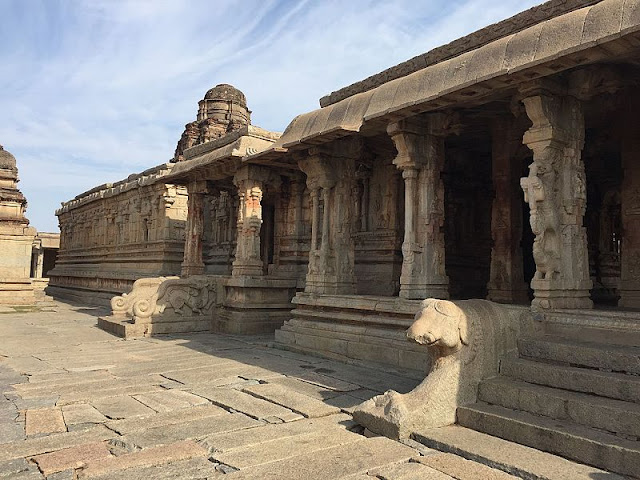Q.1. Who was the founder of Vijayanagar Empire?
(a) Harihara I and Bukka I
(b) Krishnadeva Raya
(c) Deva Raya
(d) Narasimha Saluva
Q.2. Vijayanagara kingdom was established on the banks of which river?
(a) Godavari
(b) Krishna
(c) Kaveri
(d) Tungabhadra
Q.3. Which of the following is the ruined capital of Vijayanagara Empire?
(a) Hampi
(b) Halebid
(c) Pattadakal
(d) Madurai
Q.4. The distinction of bringing ruins of Vijayanagar empire at Hampi to light is given to
(a) T. S. Burt
(b) Colonel Colin MacKenzie
(c) C. J. Franklin
(d) John Marshal
Q.5. Vijayanagara rulers adopted the emblem of the ‘varaha’ or boar. The symbol was earlier a royal insignia of which of the following kingdoms?
(a) Hoysalas
(b) Kakatiyas
(c) Chalukyas
(d) Rashtrakutas
Q.6. Harihara I and Bukka I belonged to ____ dynasty, one of the four main dynasties, combination of which is known as the Vijayanagar empire.
(a) Saluva Dynsty
(b) Tuluva dynasty
(c) Sangama Dynsty
(d) Aravidu dynasty
Q.7. The greatest Vijayanagara ruler Krishnadevaraya erected the pillar of victory (Vijayastupam) at ________.
(a) Cuttack
(b) Srisailam
(c) Hampi
(d) Simhachalam
Q.8. Krishnadeva Raya's magnum opus Amuktamalyada was written in _______.
(a) Tamil
(b) Telugu
(c) Kannada
(d) Malayalam
Q.9. Who among the following had founded a new city named Nagalapur?
(a) Deva Raya II
(b) Virupaksha Raya
(c) Krishnadeva Raya
(d) Sadasiva Raya
Q.10. In which year was the Madurai Sultanate annexed to the Vijayanagara Empire?
(a) 1335
(b) 1336
(c) 1358
(d) 1378
Answers
1-a
Notes
Vijayanagar Empire was founded by Harihara I and Bukka I. Vijayanagar’s first dynasty which lasted from 1336 to 1485 was named after Sangama, father of the duo. After Harihara, Bukka ruled from 1356 to 1377.
2-d
Notes
The nucleus of the Vijayanagar kingdom was the city of Vijayanagar, identified with present day Hampi (located on the banks of the Tungabhadra River) in Karnataka.
3-a
Notes
The nucleus of the kingdom was the city of Vijayanagar, identified with present day Hampi (located on the banks of the Tungabhadra River) in Karnataka.
4-b
Notes
Colin Mackenzie was born in Scotland in 1754. He was the first Surveyor General of India. He was the first to bring to the world's attention the rich architectural heritage of the Vijayanagara ruins at Hampi.
5- c
Notes
The Vijayanagara kingdom had adopted the emblem of the Chalukyas, varahaas or boar their royal insignia.
6-c
Notes
Harihara I and Bukka I belonged to the Sangama Dynsty, one of the four main dynasties, combination of which is popularly known as the Vijayanagar Empire.
7- d
Notes
Krishnadevaraya had erected the pillar of victory at Simhachalam (in Andhra Pradesh) in course of his eastern expedition.
8-b
Notes
Krishnadeva Raya wrote Amuktamalyada in Telugu. Amuktamalyada is a work on polity.
9- c
Notes
Krishnadeva Raya founded a city called Nagalapuram named after his mother Nagalamba. He built several temples there. Nagalapuram in Chittoor district of Andhra Pradesh is 20 km from Puttur in Dakshina Kannada district in Karnataka.
10- d
Notes
The Madurai Sultanate was annexed to the Hindu kingdom of Vijayanagar in 1378. The victory has been celebrated in the Sanskrit epic poem Madura Vijayam (Conquest of Madurai) or Kamparaya-Charitam (History of Kampanna), composed by Ganga Devi, queen of Vira Kampanna, who led the Vijayanagar army. Vira Kampanna was the son of Bukka I, co-founder of Vijayanagar empire.

.jpg)





